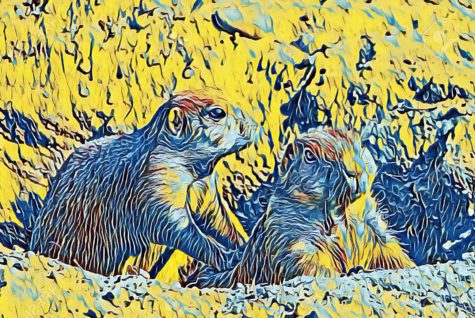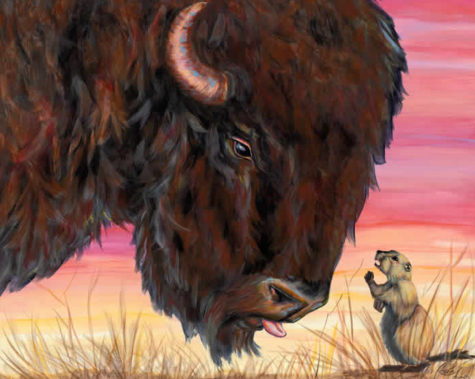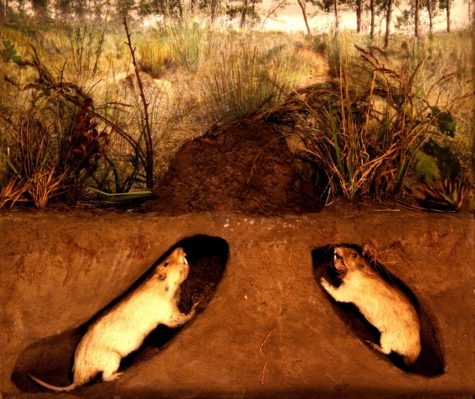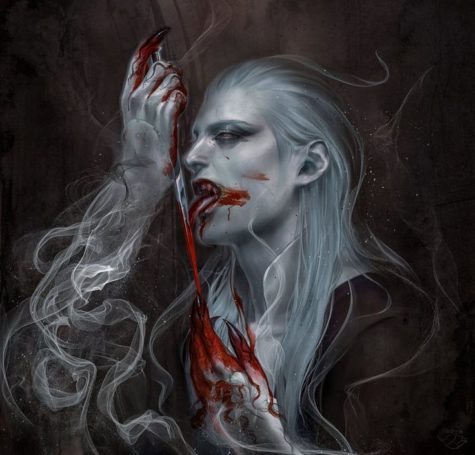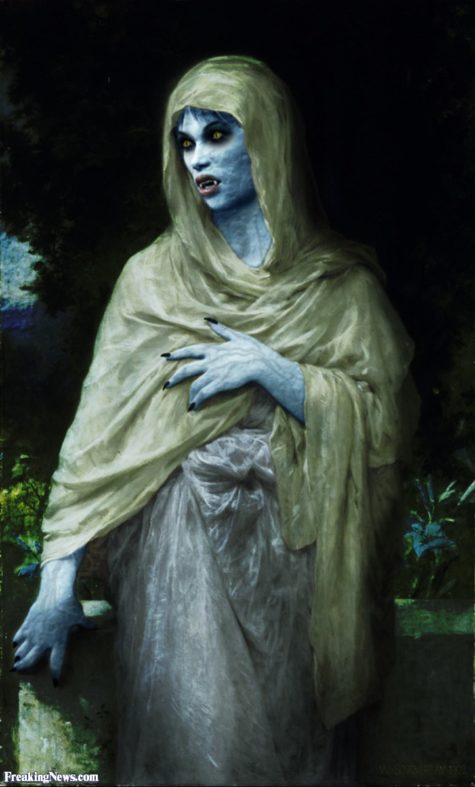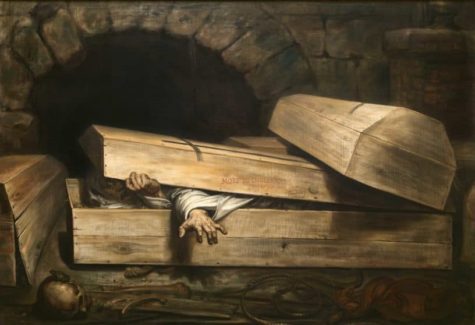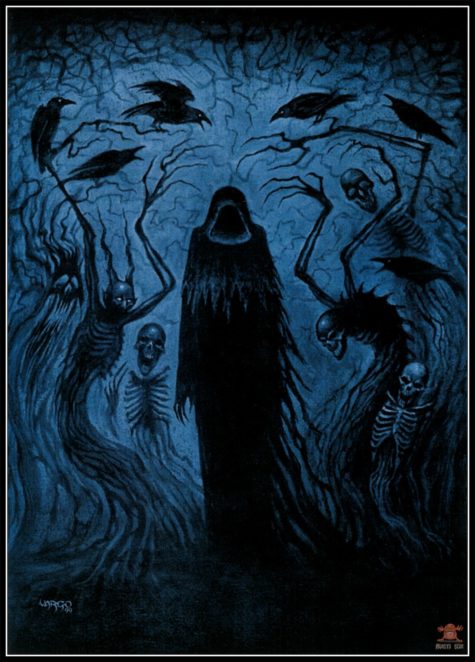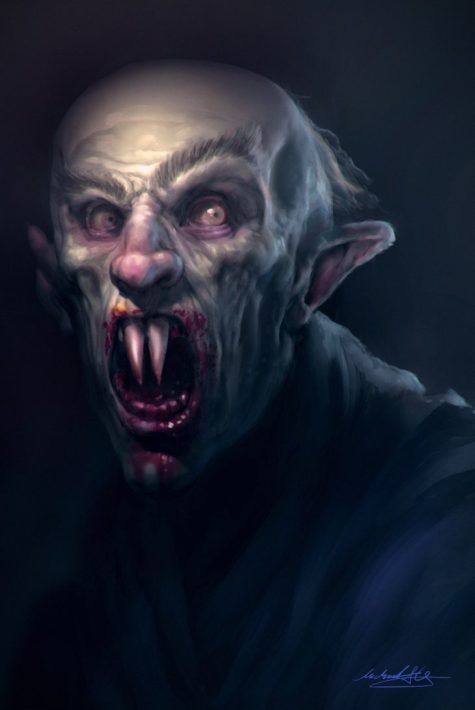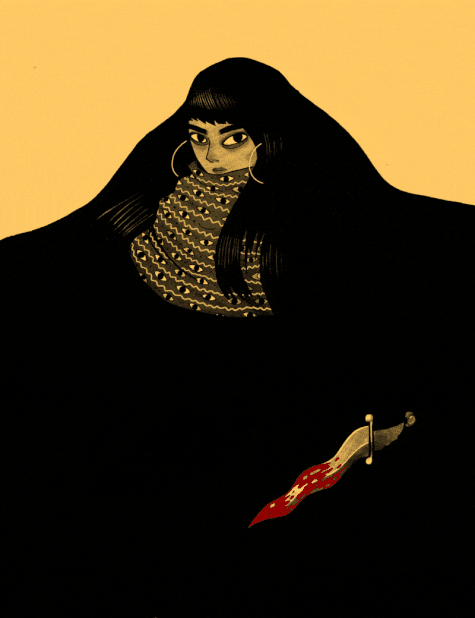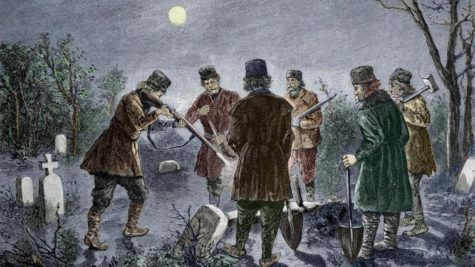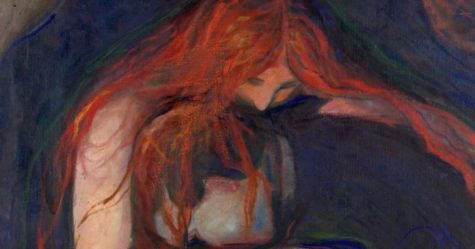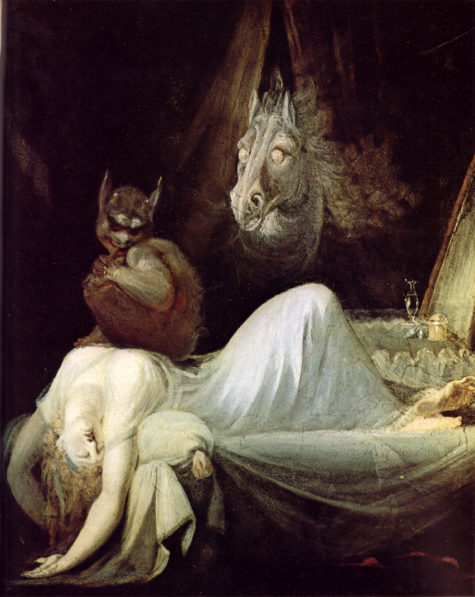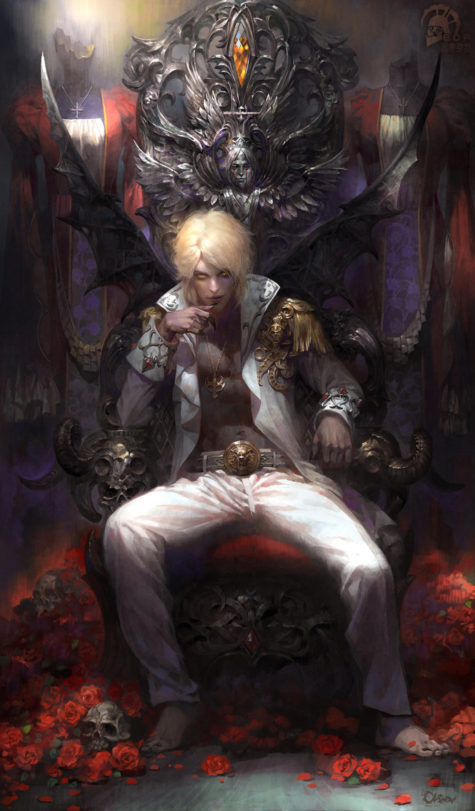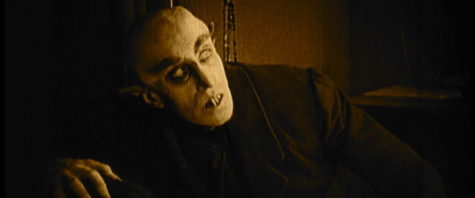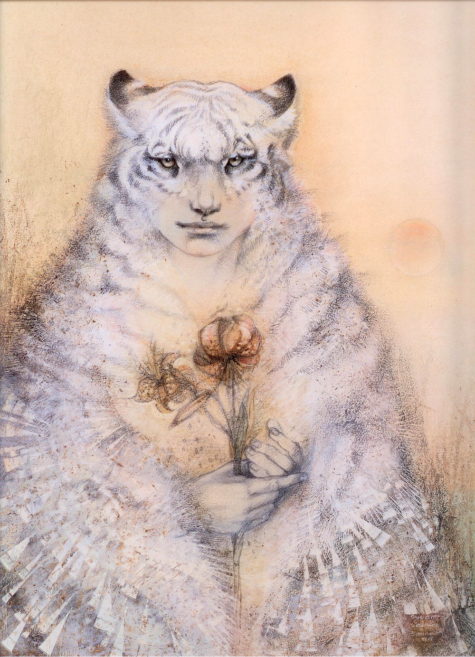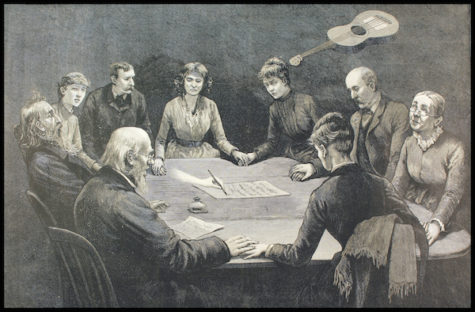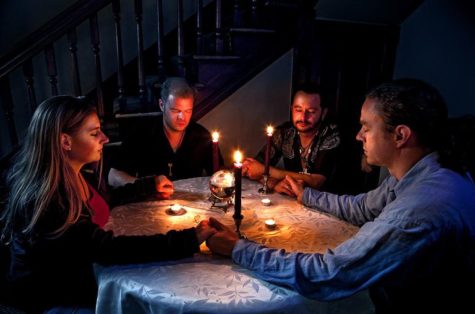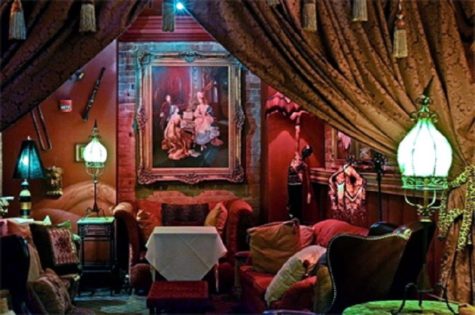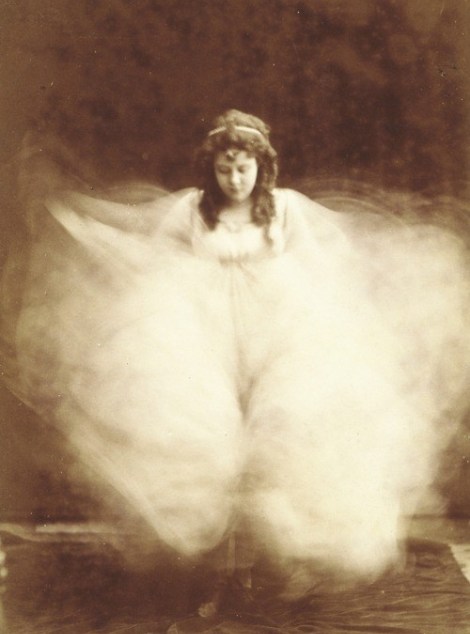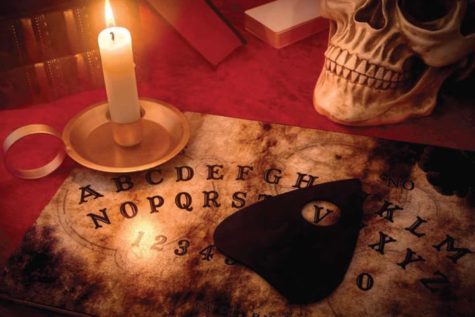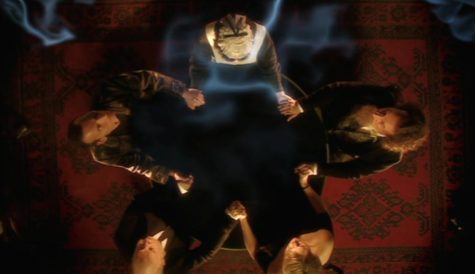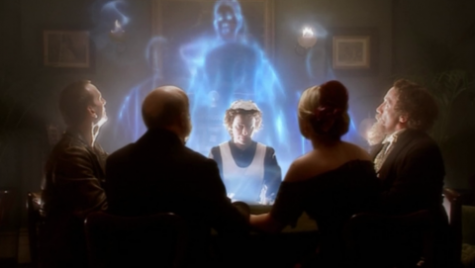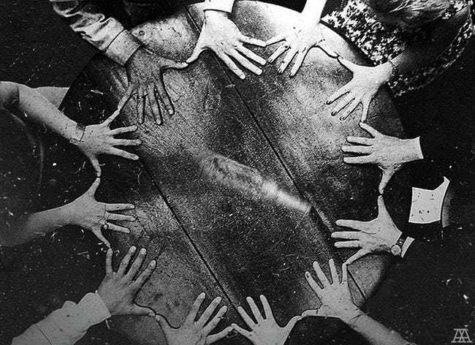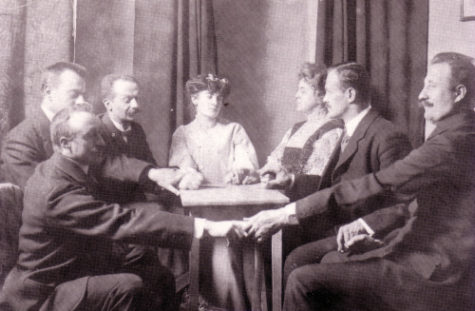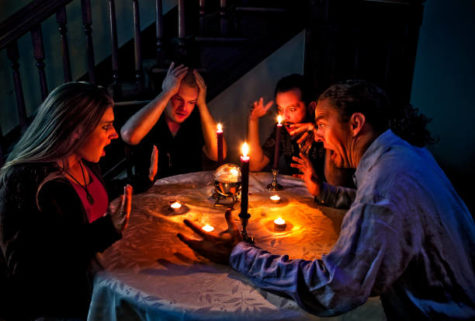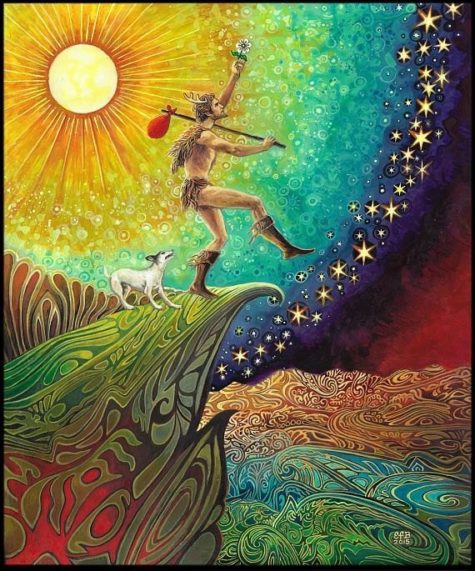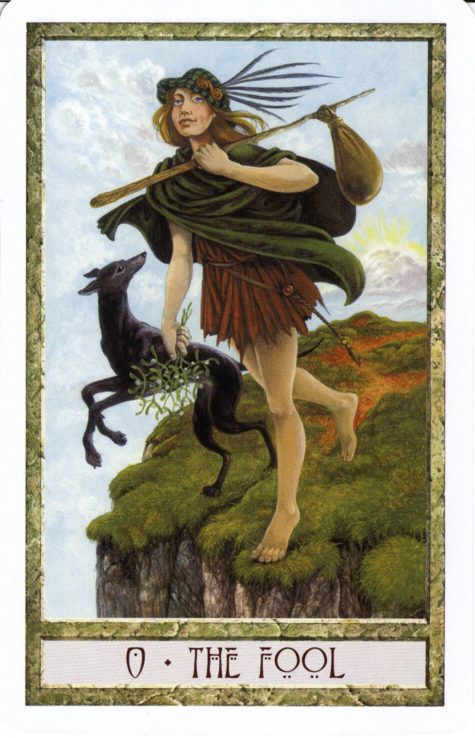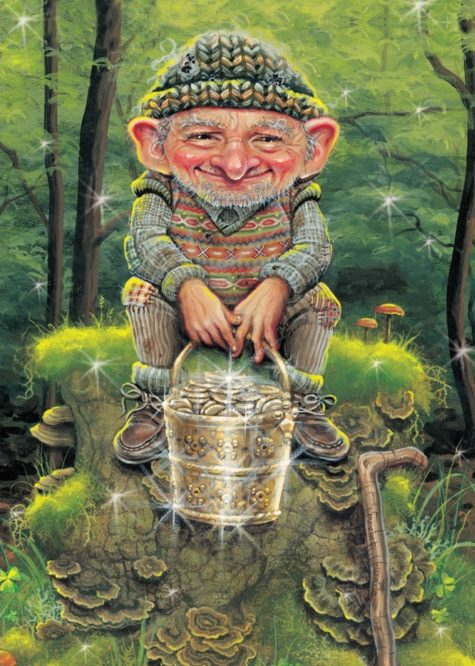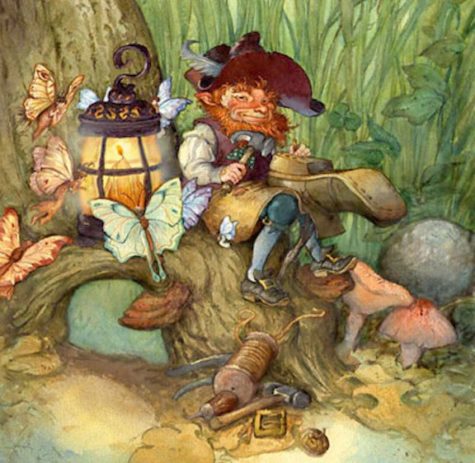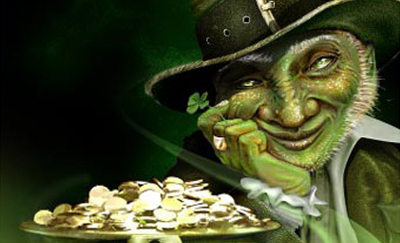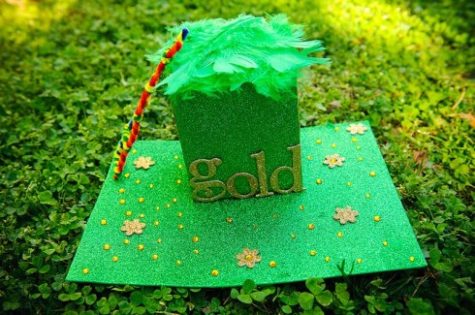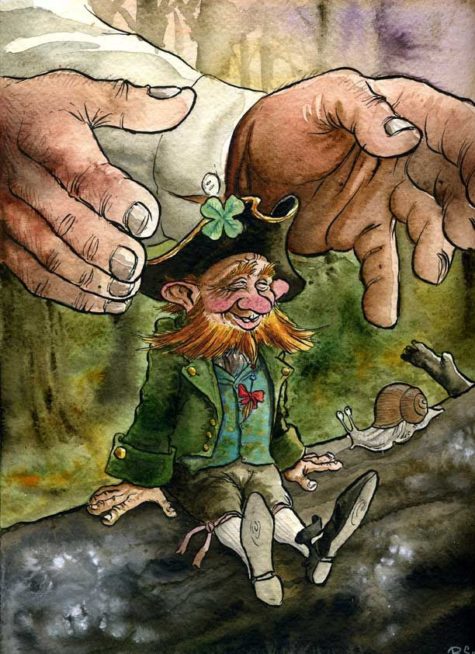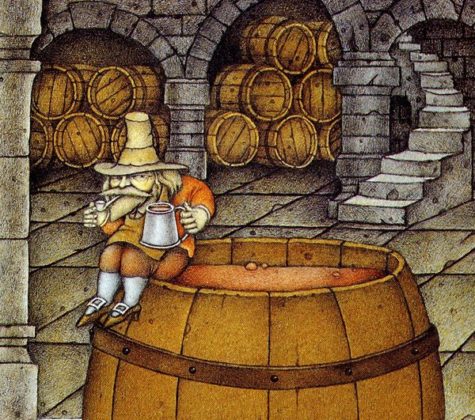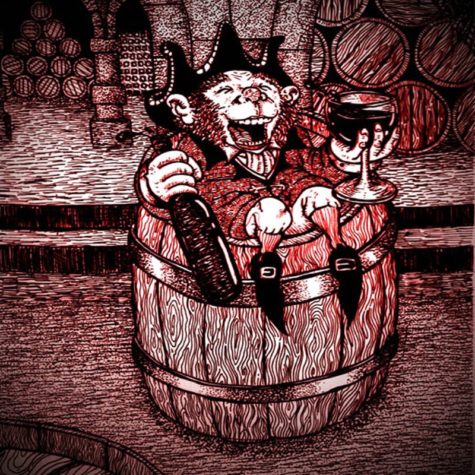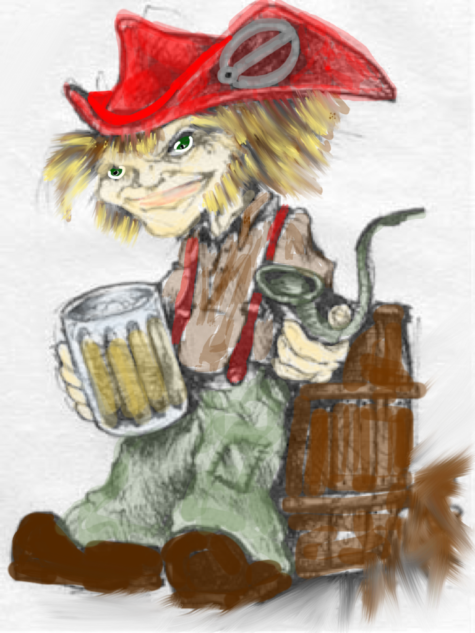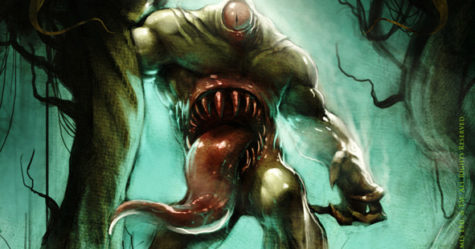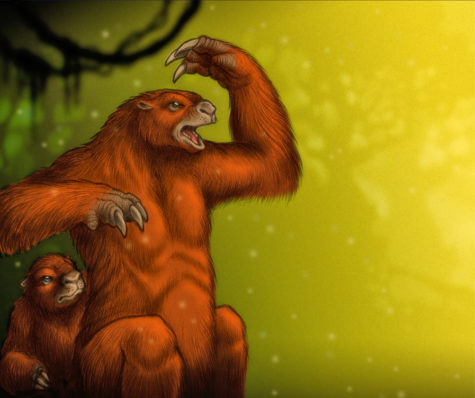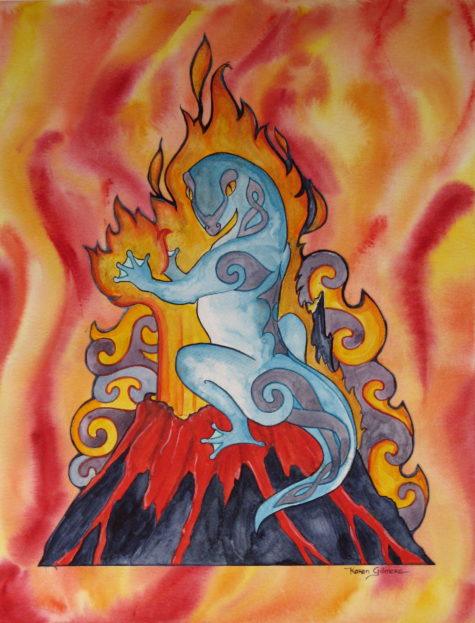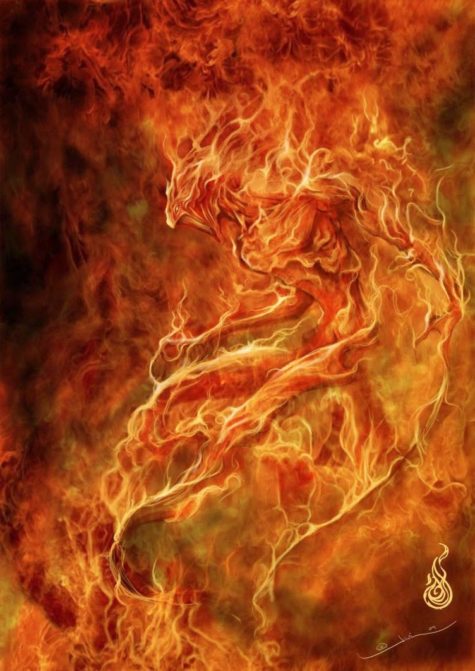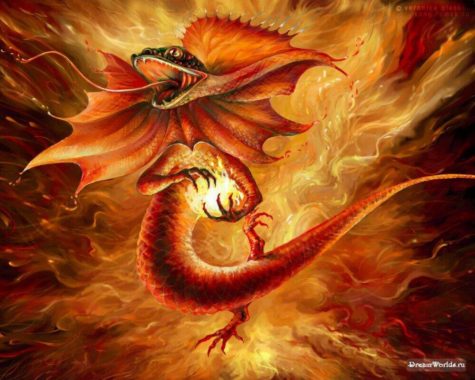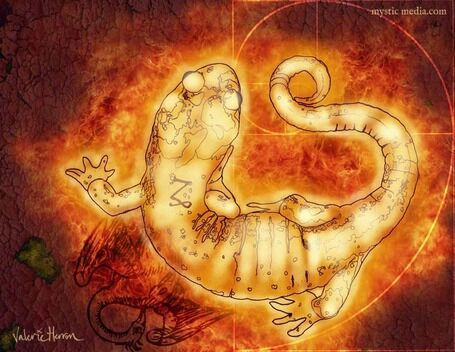Yearly Archives: 2019
Gophers live in colonies and understand the meaning of family and trusting in others. They have a very cool communication between them, which includes speaking in clicks and whistles, as well as with a special ultrasonic whistle for family members.
As a being that lives underground, they are said to be “Secrets of Life” Keepers. They are also known to be Masters of “As above, so below”. They live underground in tunnels that intersect and connect, keeping them safe underground for extended periods of time. But whether life is above ground, or below it, or even in the water, their series of tunnels demonstrate how everything is connected, even though it may be hidden from us.
Gopher is a master at knowing how to dig and uncover hidden truths and meanings and she/he shares this gift with you. Gophers have poor eyesight (in part because of spending a lot of time underground in the dark, and because they are small) so they will keep watch on the tallest point of land in order to be able to see movement so they can warn their colony.
And of course, they are very adept to feeling vibrations in the ground, which is usually why we don’t see them often, as they have advance warning of oncoming visitors. Gopher has beautiful attributes and not to be seen as a pest like many do, as they try to run them off, or worse, from their homes, especially because they love our gardens too.
They feed from their tunnels, pulling down plants and run around with ease and speed, able to jump down small holes instantly. But rather than see them as a nuisance, it would be of more benefit and compassion to observe the Gopher’s wisdom and get more acquainted with what they have to share.
Gopher showing up in your life is asking you to feel all around you and to be present with the vibrations of energy you pick up, are sensing, and intuiting. Their medicine teaches you how to attune yourself to these spiritual and physical vibrations and sensations, as well as teaches abilities to listen, feel, and heighten your intuition to be able to tune into the guidance of direction your innate instincts are leading you to. Then to be do the energy work that what you are feeling is presenting to you.
They bring a message of looking to your own growth process and observing where you plant your seeds, and ask you to take responsibility for your actions instead of adopting a victim role and blaming others. Gopher also helps us develop the skill of uncovering hidden truths and meanings and all that lies beneath a situation, which would include our shadow parts.
He/she also shows us how to listen to and align with perfect timing to take of the many choices available and how those choices are interconnected. Perhaps it is time to “dig” with a sense of purpose and direction or perhaps it is time to utilize your resources that you have before you – because you are more prepared than you realize, but just haven’t trusted yourself enough to just go for it – get it….”go pher” it. 🙂
So our amazing little Gopher friends shows you how to maneuver with purpose and keep the balance of instincts in tune with the heartbeat of our beautiful Earth. Gopher offers us wisdom of deeper truths that are awaiting us to pay attention to and then to follow their flow.
Native American Gopher Mythology
Gophers are considered to be messengers of the underworld by many western tribes, and are sometimes seen as a symbol of death. In some Shoshone and Paiute traditions, gophers were considered medicine animals who could cause or cure sickness in people, and birth defects were said to be the result of pregnant women eating vegetables a gopher had touched.
In Northern California tribes, a gopher digging near a family’s home is thought to be an omen of illness or death; in the Karuk tribe, it was considered bad luck to kill or eat gophers. In Klamath and Modoc mythology, Gopher was the younger brother of the Creator and played a role in the tribal creation myth. Gophers sometimes appear as healers or wise advisors in Native folklore.
Gophers are also used as clan animals in some Native American cultures. Tribes with Gopher Clans include the Hopi tribe (whose Gopher Clan was named Mui-wungwa) and the Pueblo tribes of New Mexico.
Dreaming About Gophers
To see a gopher in your dream means that you are being used and manipulated by others out of survival needs. Below are more gopher related dream interpretations in various contexts.
- Dream About Hitting Gopher
To hit or beat a gopher in the dream, suggests that you should “go for it”. Take initiative and act now to grab that fleeting chance.
- Dream About Gophers Digging
Dreaming about gophers digging in and out of places, reflects the various path that you could take in the near future. These choices are all interconnected and sometimes you simply have to make a judgment call on the best path.
- Dream About Gopher Tunnel
Seeing gophers tunnels signifies the need to maneuver your path while using the balance of your instincts. Always keep your options open and leave yourself with more diverse entrances and exits is key to your survival.
- Dream About Gopher Hiding
To dream about gopher hiding away in its tunnel, represents how you feel unnoticed by others, may it be the good or the bad that you do. The dream suggests that you may need to find ways to stand up for yourself.
- Dream About Catching and Baiting Gopher
Dreaming about setting up traps to try and bait catch gopher, refers to your skill at uncovering hidden truths and meanings. Try to look beneath a situation and figure out the true cause, you will only be able to solve your problems at hand by digging a little deeper and be patient.
- Dream About Gopher Mounds
To see gopher mounds in the dream, represents that you should better utilize the resources you have before you. You might be using resources or assets behind other people’s back. Be careful about the evidences or you would be caught red handed and found guilty.
- Dream About Gopher Destroying Your Garden
Dreaming about your beautiful garden being destroyed or eaten by a gopher, suggests that an employee, contractor, or someone that you work with may be stealing behind your back. However, this generally because you may be underpaying or taking advantage of those whom you work with. They may be forced to take unethical rebates or kickbacks in order to survive.
Gophers vs Groundhogs
Despite their similar appearances and burrowing habits, groundhogs and gophers don’t have a whole lot in common—they don’t even belong to the same family. For example, gophers belong to the family Geomyidae, a group that includes pocket gophers (sometimes referred to as “true” gophers), kangaroo rats, and pocket mice.
Groundhogs, meanwhile, are members of the Sciuridae (meaning shadow-tail) family and belong to the genus Marmota. Marmots are diurnal ground squirrels, Daniel Blumstein, a UCLA biologist and marmot expert, tells Mental Floss. “There are 15 species of marmot, and groundhogs are one of them,” he explains.
Science aside, there are plenty of other visible differences between the two animals. Gophers, for example, have hairless tails, protruding yellow or brownish teeth, and fur-lined cheek pockets for storing food—all traits that make them different from groundhogs. The feet of gophers are often pink, while groundhogs have brown or black feet. And while the tiny gopher tends to weigh around two or so pounds, groundhogs can grow to around 13 pounds.
While both types of rodent eat mostly vegetation, gophers prefer roots and tubers (much to the dismay of gardeners trying to plant new specimens), while groundhogs like vegetation and fruits. This means that the former animals rarely emerge from their burrows, while the latter are more commonly seen out and about.
Groundhogs “have burrows underground they use for safety, and they hibernate in their burrows,” Blumstein says. “They’re active during the day above ground, eating a variety of plants and running back to their burrows to safety. If it’s too hot, they’ll go back into their burrow. If the weather gets crappy, they’ll go back into their burrow during the day as well.”
But that doesn’t necessarily mean that gophers are the more reclusive of the two, as groundhogs famously hibernate during the winter. Gophers, on the other hand, remain active—and wreck lawns—year-round.
“What’s really interesting is if you go to a place where there’s gophers, in the spring, what you’ll see are what is called eskers,” or winding mounds of soil, Blumstein says. “Basically, they dig all winter long through the earth, but then they tunnel through snow, and they leave dirt in these snow tunnels.”
Sources:
No after-death spirit retains as much fascination for the living as does the vampire. Popularly known as the un-dead, many understand vampires to exist on a plane somewhere between the realms of the living and the dead. Are vampires tortured souls of the dead, compelled to feed upon the living? Or are they souls rewarded with eternal life, able to achieve the alchemist’s ultimate fantasy without spending endless hours shut up in a laboratory?
Who or what exactly are vampires? Interpretations differ; “vampire” is a catch-all word that encompasses many concepts. However, one quality is held in common by all vampires: they suck vitality from others.
The most notorious literary and cinematic vampires, like Bram Stoker’s Dracula, Sheridan Le Fanu’s Carmilla, or the inhabitants of Anne Rice’s novels, are blood-suckers. Some vampires kill their victims by draining them of all their blood immediately. More sensuous vampires prolong the process: it isn’t the loss of blood that ultimately kills the victim. The blood is merely the means for the vampire to drain the victim’s life force away?
Another interpretation suggests that a vampire may not be dead at all but a living sorcerer able to send out his or her shadow soul (and recall it when desired) and that this soul is interpreted by others as a vampire.
The Historical Vampire
The concept of vampirism dates back thousands of years. The ancient Greeks, Hebrews, Egyptians and Babylonians all had legends telling hair-raising tales of demon-like un-dead creatures that lived off of the blood of the living.
Tales of the un-dead consuming the blood or flesh of living beings have been found in nearly every culture around the world for many centuries. Today we know these entities predominantly as vampires, but in ancient times, the term vampire did not exist; blood drinking and similar activities were attributed to demons or spirits who would eat flesh and drink blood; even the devil was considered synonymous with the vampire.
Almost every nation has associated blood drinking with some kind of revenant or demon, from the ghouls of Arabia to the goddess Sekhmet of Egypt. Indeed, some of these legends could have given rise to the European folklore, though they are not strictly considered vampires by historians when using today’s definitions.
Hebrews, ancient Greeks, and Romans had tales of demonic entities and blood-drinking spirits which are considered precursors to modern vampires. Despite the occurrence of vampire-like creatures in these ancient civilizations, the folklore for the entity we know today as the vampire originates almost exclusively from early 18th-century Southeastern Europe, particularly Transylvania as verbal traditions of many ethnic groups of the region were recorded and published. In most cases, vampires are revenants of evil beings, suicide victims, or witches, but can also be created by a malevolent spirit possessing a corpse or by being bitten by a vampire itself. Belief in such legends became so rife that in some areas it caused mass hysteria and even public executions of people believed to be vampires.
In India, tales of vetalas, ghoul-like beings that inhabit corpses, are found in old Sanskrit folklore. Although most vetala legends have been compiled in the Baital Pachisi, a prominent story in the Kathasaritsagara tells of King Vikramāditya and his nightly quests to capture an elusive one. The vetala is described as an undead creature who, like the bat associated with modern-day vampirism, hangs upside down on trees found on cremation grounds and cemeteries. Pishacha, the returned spirits of evil-doers or those who died insane, also bear vampiric attributes.
The Hebrew word “Alukah” (literal translation is “leech”) is synonymous with vampirism or vampires, as is “Motetz Dam” (literally, “blood sucker”). Later vampire traditions appear among diaspora Jews in Central Europe, in particular the medieval interpretation of Lilith. In common with vampires, this version of Lilith was held to be able to transform herself into an animal, usually a cat, and charm her victims into believing that she is benevolent or irresistible. However, she and her daughters usually strangle rather than drain victims, and in the Kabbalah, she retains many attributes found in vampires.
A late 17th- or early 18th-century Kabbalah document was found in one of the Ritman library’s copies of Jean de Pauly’s translation of the Zohar. The text contains two amulets, one for male (lazakhar), the other for female (lanekevah). The invocations on the amulets mention Adam, Eve, and Lilith, Chavah Rishonah and the angels—Sanoy, Sansinoy, Smangeluf, Shmari’el, and Hasdi’el. A few lines in Yiddish are shown as dialog between the prophet Elijah and Lilith, in which she has come with a host of demons to kill the mother, take her newborn and “to drink her blood, suck her bones and eat her flesh”. She informs Elijah that she will lose power if someone uses her secret names, which she reveals at the end.
Other Jewish stories depict vampires in a more traditional way. In “The Kiss of Death”, the daughter of the demon king Ashmodai snatches the breath of a man who has betrayed her, strongly reminiscent of a fatal kiss of a vampire. A rare story found in Sefer Hasidim #1465 tells of an old vampire named Astryiah who uses her hair to drain the blood from her victims. A similar tale from the same book describes staking a witch through the heart to ensure she does not come back from the dead to haunt her enemies.
How does one become a vampire?
Although some spirits are believed to be innately vampiric, transcending rhyme or reason, Different traditions cite different causes, some much crueler than others if one considers the implications.
In actual Transylvanian folklore, illegitimate sons, born outside Church-sanctioned marriages, are doomed to become vampires. Ukranian folklore perceives vampires as the inevitable result of sexual relations between witches and werewolves.
And so we find that people can become vampires not only through a bite, but also if the following situations were to occur:
- According to other legends, those born on Christmas Day are potentially future vampires.
- Were an illegitimate child of parents who were illegitimate.
- Died before baptism.
- Anyone who has eaten the flesh of a sheep killed by a wolf.
- If you were the child of a pregnant woman who was looked upon by a vampire.
- You were given inadequate, improper funeral rites.
- If you are a nun who stepped over an unburied body.
- If you had teeth when you were born.
- Or maybe you were once a werewolf.
- You practiced sorcery before your death.
- A cat jumped on your corpse before you were buried (England and Japan).
- A baby born with teeth.
- A stillborn.
- A bat flying over a corpse (Romania).
- Being excommunicated by the Orthodox Church (Greece).
- Being the seventh son of the seventh son.
- A dead body that has been reflected in a mirror.
- Red heads (Greece).
- People who die by suicide or sudden, violent deaths.
- People who were improperly buried; renouncing the Eastern Orthodox religion.
In folklore, the vampire’s first victim would often be his wife. This is why, in some cultures, when a husband died, the wife would change her appearance, i.e. she would cut her hair and would wear black for the entire period of mourning. These things were done with the intention of deceiving the vampire, should he return.
According to some legends, a vampire may engage in sex with his former wife, which often led to pregnancy. In fact, this belief may have provided a convenient explanation as to why a widow, who was supposed to be celibate, became pregnant. The resulting child was called a gloglave (pl. glog) in Bulgarian or vampirdzii in Turkish. Rather than being ostracized, the child was considered a hero who had powers to slay a vampire.
A completely different idea of how vampires are made can be found in this article by J.L.N. Lewitin.
- Intimate infection from a demon:
There is a contagious quality to being a vampire. One vampire infects, initiates and creates another. Having been attacked by a blood-sucking vampire, according to this school of thought, one either becomes a vampire oneself or dies.
When a vampire, or demon, infects a mortal in such a way that they bind with the physical body of the creature, they can often pry the soul out of control of the body and permanently remove it. The power of the demon fuels the initial removal of the soul, as well as the first few hours of action. After this, most vampires will require the blood or soul of other conscious beings. Over time the demon will become more efficient at extracting the energy from these sources, and will require less. However initially, the need will be quite great.
This method of infection can also be transmitted to other conscious beings through the sharing of blood. In this way the demon within the initial vampire can multiply itself. The power of the second vampire will be slightly less then its makers, however over time it will also increase. There is also some speculation that when the initial vampire is destroyed, if the demon is eradicated with it, that all of the vampires born of that demon will also be destroyed.
These vampires tend to be the most powerful, and possess the strongest attributes. This is because the energy of the demon fuels the initial transformation, and the first few hours of existence. The demon also helps the body to become accustomed to its new existence, and can synthesize the souls or blood of other creatures, making it a useable source of energy. They also make it easier for the body to tap into telekinetic, psychic, and magical powers, as well as the new physical power within its body.
- Infection from a virus:
Some viruses can cause a change in the body which destroys it in such a way that the soul fleas, but the physical brain retains some control over the creature’s actions. Initially such beings will be extremely weak and may be mistaken for dead. However, if they gain a source of energy, and a way to synthesize it into something they can use, they may be able to cobble together a consciousness. Their energy source may be the blood or souls of humans, or might be some other form of magic or chemical energy.
These vampires are marked by weakness, and a lack of consciousness. They are often compared to zombies, with the main difference being that vampires do not seam to degenerate after the initial change, while zombies are in a constant state of decline.
- Vampirism by mental disease:
In rare cases a person’s physical mind can become obsessed with the sensual body to such an extent that it begins to revolt against the creatures inner soul. This is usually a violent struggle, and can be very painful and difficult for the victim.
As the soul is removed the creature begins to require alternate sources of energy to fuel its consciousness. In these scenarios, blood or souls are as likely as any other source to become the fuel, as the creature does not possess the ability to synthesize blood into a useable form. Some cases have been observed where vampires of this type become voracious eaters, others draw their energy from fire, and others use magical means to fuel themselves.
Traditional Vampires
Contrary to popular Hollywood movies, blood-sucking vampires tend to be an aberration. Although they did exist prior to Bram Stoker’s incredibly influential best-selling 1897 novell, Dracula, they were rare and very much a product of Gothic fiction.
Traditional folkloric vampires have comparatively little to do with many literary or movie vampires. Vampire traditions exist throughout virtually all of Eastern and Central Europe. Similar sounding words exist in Slavic, Finno-Ugric, and Romance languages. Variations include:
- Upir
- Wampir
- Vampyr
- Upior
Traditionally speaking, vampires are understood as revenants, living corpses of witches, sorcerers, shamans, and/or magickal practitioners who, for one reason or another, rise from the grave. At their most neutral, they are harmful merely because they are not obeying natural laws; at their worst, they rise with the deliberate intent to cause harm.
Although little or no notion of blood-sucking exists in the original conception, that doesn’t mean a vampire isn’t potentially dangerous. Because vampires may be in a liminal state, between life and death, they require life-energy, which is easiest absorbed from the living. However this life force is more likely to be absorbed via sexual energy or siphoning off “chi” rather than sucking blood. From this perspective, Fox Spirits who sexually drain men to the point of death are considered vampiric.
Identifying Vampires
While most people can name several elements of vampire lore, there are no firmly established characteristics. Some vampires are said to be able to turn into bats or wolves; others can’t. Some are said not to cast a reflection, but others do. Holy water and sunlight are said to repel or kill some vampires, but not others. The one universal characteristic is the draining of a vital bodily fluid, typically blood.
One of the reasons that vampires make such successful literary figures is that they have a rich and varied history and folklore. Writers can play with the “rules” while adding, subtracting or changing them to fit whatever story they have in mind.
Finding a vampire is not always easy: according to one Romanian legend you’ll need a 7-year-old boy and a white horse. The boy should be dressed in white, placed upon the horse, and the pair set loose in a graveyard at midday. Watch the horse wander around, and whichever grave is nearest the horse when it finally stops is a vampire’s grave — or it might just have something edible nearby; take your pick.
Often potential revenants, or vampiric spirits, can be identified at birth, usually by some abnormality, some defect, as when a child is born with teeth. Similarly suspicious are children born with an extra nipple (in Romania, for example); with a lack of cartilage in the nose, or a split lower lip (in Russia). When a child is born with a red caul, or amniotic membrane, covering its head, this was regarded throughout much of Europe as presumptive evidence that it is destined to return from the dead.
Banishing and Destroying Vampires
The best way to deal with vampires, of course, is to prevent them from coming back in the first place. A few centuries ago in Europe this was often accomplished by staking suspected vampires in their graves; the idea was to physically pin the vampire to the earth, and the chest was chosen because it’s the trunk of the body.
This tradition was later reflected in popular fiction depicting wooden stakes as dispatching vampires. There was no particular significance to using wood; according to folklore, vampires — like djinn (genies) and many other magical creatures — fear iron, so an iron bar would be even more effective than a wooden stake.
It was also not unusual for a corpse to be buried face down so it would dig down the wrong way and become lost in the earth.
According to several legends, if someone was bitten by a suspected vampire, he or she should drink the ashes of a burned vampire. To prevent an attack, a person should make bread with the blood of vampire and eat it.
Other traditional methods of killing vampires include decapitation and stuffing the severed head’s mouth with garlic or a brick. In fact, suspected vampire graves have been found with just such signs.
If your local villagers neglected to unearth and stake a suspected vampire and he or she has returned from the grave, there are steps you can take to protect yourself.
The exact method varies around the world, but in some traditions the best way to stop a vampire is to carry a small bag of salt with you. If you are being chased, you need only to spill the salt on the ground behind you, at which point the vampire is obligated to stop and count each and every grain before continuing the pursuit. If you don’t have salt handy, some say that any small granules will do, including birdseed or sand. Salt was often placed above and around doorways for the same reason.
In Macedonian tradition, vampires can be prevented from causing harm by scattering millet seed throughout the cemetery. Any passing vampires are compelled to obsessively pick up every tiny seed, leaving them vulnerable to the banishing rays of the sun.
Traditional vampire repellents and banishers include, bright light or sunlight, garlic, hawthorn branches, rowan trees (later used to make crosses), peppermint, onions, a rooster’s crow, silver bullets, iron bells, bullets created from melted down bell metal, thresholds (unless they’re invited in), mirrors, decapitation with a gravedigger’s spade, salt (associated with preservation and purity), running water, fire, and burying a suspected vampire at a crossroads.
Some traditions hold that vampires cannot enter a home unless formally invited in. This may have been an early form of the modern “stranger danger” warnings to children, a scary reminder against inviting unknown people into the house.
Whether crosses and Church-blessed Holy Water also repels vampires or whether this is merely Christian propaganda is subject to debate. That being said, the following might possibly repel or deter a vampire: churches, crucifixes, eucharist water, holy water, Devotees of Japanese anime will recall that those methods have no effect on Vampire Princess Miyu.
To destroy a vampire, you can:
- Burn it.
- Bury the corpse facedown.
- Drive a wooden stake through its heart.
- Pile stones on the grave.
- Put poppy seeds or wild roses on the grave.
- Boil the head in vinegar.
- Place a coin in the mouth and decapitate with an axe.
- Put a lemon in the mouth.
- Bury at a crossroads.
- Remove the heart and cut it in two.
- Put garlic in the mouth and drive a nail through the temple.
- Cut off the toes and drive a nail through the neck.
- Pour boiling oil on the body and drive a nail through the navel.
More more spells and rituals to banish, deter, repel, and possibly even make peace with vampires can be found at the Book of Shadows and Gypsy Magick and Lore.
Metaphorically Speaking
Vampirism can be understood metaphorically as well as literally: that may not be just any old blood the vampire is draining. Menstrual blood may be perceived as symbolizing women’s mysteries and magick powers. The male vampire depicted preying upon a young woman may be perceived as either attempting to appropriate or annihilate her special power.
Literary and cinematic vampires typically possess a sexual element. To some extent that type of vampire combines the blood-sucker with more ancient incubus (male) and succubus (female). Incubi and succubi are spirits, vampiric creatures who suck and drain sexual vitality, often through sexual intercourse, whether actual physical intercourse or through dream hauntings. Although the visitations may occur in dreams, the severe devitalization is apparent upon awakening.
Philosophy of the Vampire
Vampires are born out of a fundamental change which can occur in the physical bodies of creatures which possess a soul. In most mortals the soul is the fundamental source for action, creating the original impulses which eventually become the person’s acts. It is also a passage through which the creature can gain a small amount of the infinite power underlying the universe, power which is necessary for the functioning of a self conscious being.
A vampire is born when a mortal creature undergoes a change which causes the sensual physical body to revolt against the soul, usually expelling it, and taking control of the creature. The actions of the being are then controlled by either the remaining physical brain, the remnant of the soul, whatever caused the expelling of the soul, or a conglomerate of these forces. It is this emphasis on the physical body to the exclusion of the soul, which causes many vampires to be obsessively sensual and addicted to their own suddenly intense perceptions.
There are many things which can cause a creature to become a vampire. These include certain forms of intimate demonic possession, various viruses, the casting of spells to become a vampire, or mental disease. Each of these causes has its own peculiar nature, and can result in very different outcomes for the victim.
The change into a vampire is almost always accompanied by physical changes in the creature’s body. The most common of these is a removal of the ability to feel pain, and a fundamental change in their perception of the world. These are caused by the sudden lack of soul, which influences the way everything looks and feels.
The immortality of the creature comes due to a perceptual change. The body in complete control of itself does not choose to harm itself with entropy, and so stops doing it. However it is the soul which provides a creature with true wisdom and this form of immortality almost always results in major psychological problems. While immortal, eventually almost all vampires end up committing suicide due to the pressure of their own thoughts.
Changes such as an increase in strength, the ability to fly, psychic and telekinetic powers, and magic abilities are fueled by a power source which accompanies the transformation. As such these abilities are dependent on the amount of energy within the being, and will be increased or decreased by this factor.
Energy is a major problem for vampires, who have to fuel a self conscious existence without the benefit of the soul’s pathway to the infinite power source. If a demon initiates the change, then their inherent power will fuel the initial act. If the change occurs due to a mental problem, or a mental problem caused by a virus, then the remnants of the soul and the body itself will have to fuel the initial change. This often results in vampires of very low consciousness and power.
Later energies have to come from another source, as even the initial power of a demon can not fuel a conscious being for long. This power is often gained through the drinking of the blood or souls of other self conscious creatures. Unfortunately the drinking of a soul, or soul blood, will only give a creature a limited amount of energy, requiring that the vampire repeat this act on a regular basis to survive.
The need for energy can become an obsession in vampires, overwhelming any sense of control and self they may have once had. If the need becomes too great, it can utterly destroy whatever mind remains in the creature, turning them into a zombie.
Some experiments have been done with plasma, as well as nuclear and subatomic energy sources as a way of fueling vampires. This technology is still in its infancy however, and most of the vampiric test subjects claim that these methods are still too weak to effectively sustain them.
Weaknesses Of The Vampire
The greatest weakness vampire’s face is their need for energy, often in the form of blood. Since consuming the blood and souls of conscious beings is generally opposed by the conscious beings themselves, vampires have a constant enemy that they are intrinsically tied to. They can’t live with their prey, but they can’t live without them.
If a vampire finds a way to synthesize enough energy to survive, they will usually develop a second problem. As a creature increases its ability to take energy from subtle existences such as life, they will become more sensitive to the energy in the world around them.
Generally if the vampire becomes good enough at synthesizing energy from blood or souls to survive, they will also become so sensitive to energy that sources such as the sun and fire will be extremely harmful to them. This is why many traditional demon induced vampires, who enjoy instant acclimation to vampirism, also suffer from the inability to go out in daylight. However there can be a convergence point for some vampires where they become so good at synthesizing energy that their power increases faster then their bodies sensitive to light and heat, and they become impervious to them once again.
Sources:
- Live Science
- The Pagan Calendar
- Encyclopedia of Spirits
- Element Encyclopedia of 5000 Spells
- Ancient Thoughts
- Thought Catalogue
The animal kingdom is very important to those who immerse themselves in natural magick. Sometimes you may want to communicate with animals or simply see the world through their eyes. A simple spell for merging your mind with animals is as follows:
Center yourself by sitting or lying upon the ground, closing your eyes, and imagine a whirlpool of energy surrounding you, travelling in clockwise motion from your head down to your feet, back up to your head, and back down to your feet. Continue this imagery until you feel grounded and centered, oblivious to daily distractions and cares. Once centered, allow your mind to wander to the animal you wish to merge with. Don’t force the imagery, rather allow it to happen.
Picture the animal clearly in your mind. Watch it, empathize with it, feel yourself merging with it. Imagine what it is like to be the animal. Imagine the sights it sees, the smells it senses, the motivations and ways of thinking it may have. Become those thoughts. Merge with the animal by dissolving the distinctions that make it separate.
Once you have fully merged with the animal, you can communicate with it. Ask it what you want to know. Tell it what you want it to know
Source: simplemagick.com
Throughout the Victorian age, parties that featured a séance were all the rage. Hosts would gather people together to contact the dead. In recent years, there has been increased skepticism towards séances. However, a lot of people continue to believe that making contact with the dead is possible.
Hosting a séance can be an emotional, yet satisfying experience. When hosting your meeting, proceed with caution and patience to get the best results.
If you decide to try to conduct a séance at home, expect some awkwardness, especially on your first try. I’ve always thought that beginner’s séances were like a scene in a movie about teenagers away at summer camp, where the girls and boys from across the lake are thrown together for a one-night dance. In a séance, of course, it’s not about overcoming the gender divide, but the gap between the living and the dead. Like hapless teens, there’s a lot of hesitancy on both sides, and communication doesn’t always come easy—especially considering the dead don’t usually have audible voices!
Supplies and Necessities:
If you’re planning to hold a séance in your own home, you need a few like-minded people and a few vital supplies.
- Choose good company.
A séance generally requires a minimum of three people; one to be the medium, who contacts and channels the spirits, and at least two others to provide supportive energy. Make sure you choose friends who are respectful, comfortable with the supernatural, and focused—your friend who can’t stop fidgeting with his phone in a movie theater is likely to bring that same distracted mood to your séance.
Some say the number of participants must be divisible by three. But this does not seem to be an absolute rule. No fewer than three people should attempt a séance, as it can be emotionally and physically exhausting on a small group.
Séances are tricky business, and you don’t want to invite people who are going to ruin the atmosphere with negative attitudes, or by poo-pooing the entire event. Even if you don’t end up chatting with something from beyond the grave, you still want to have a good time. If you invite skeptical people to the séance, then the positive atmosphere is going to be wrecked and you probably won’t get a chance to communicate with any spirits. When you send out the invites, make sure you tell your cool friends to come, and the more open they are to the idea of a spirit world, the better.
Also, because the experience can be intense, it is usually best to keep young children and pets out of the circle.
- Make a space for spirits.
If you’re hosting your first séance, what should you have available? If you’re using a tarot deck, use your favorite set. If you don’t have a favorite set, just use one that speaks to you. There are a variety of tarot decks, and you’re sure to find something that’s your style.
If you’re certain that you’re going to speak with something from beyond the grave, then bring a voice recorder to pick up the audio from the session – you never know what you’re going to hear.
Although séances in film are usually held in romantic rooms with oaken round tables, you might live in a cramped apartment furnished exclusively by Ikea. That’s okay! A few modifications can make even the grungiest space more inviting to otherworldly visitors.
Some séance instructions ask for a round table. This helps create the symbolic circle believed necessary for the ritual, also a square or rectangular table might make it more difficult to join hands. If a square or rectangular table is all that is available, it will be fine. You can use a table cloth or central altar to create the symbolic circle, and arrange the seating so that it is comfortable for everyone to join hands.
Candles, incense, and burnt sage can all boost the psychic power of your space. Both the candles and food are believed to attract spirits who are looking for warms and sustenance.
In the center of the table, place some simple and naturally aromatic food, such as bread or soup. This is believed to help attract the spirits who still seek physical nourishment. Also in the center of the table, place no fewer than three candles (or a number divisible by three) lit candles; the more candles, the better. Spirits still seek warmth and light.
Dim the lights and eliminate any distractions. Turn off all music and the television. Do make sure you’ve turned off alarm clocks, phones, and any other distracting electronics—some mediums even find that electronic devices interfere with their psychic senses.
- Trim Your Expectations
It’s best if you don’t expect anything. Even highly experienced mediums, who use familiar spirit guides to contact new spirits, run into unexpected setbacks—the dead person they’re trying to reach isn’t answering, or they’re only interested in chatting about their favorite mug (yes, this happens) and don’t respond to the important questions about the afterlife.
Sometimes, an attention-seeking spirit can even intrude on a private conversation. If the world’s most talented mediums experience some unpredictable hi-jinks and complications, you’d better bet you will, too. So, as much as you can, roll with the flow of your séance, and try not to form any expectations before you start.
- The Medium.
Mediums are, in effect, translators between the spirit and earthly realms, and they can dramatically ease the process of getting in touch with a disembodied presence. You might want to choose a medium among the participants. This could be a person who has had experience with séances or someone who has displayed that they’ve got psychic abilities.
Although it’s strange to think of spiritual affairs as a skill, mediumship is not that much different from any other talent. Your first (or second or third) attempt might feel awkward or even disastrous as you learn how to hold a séance, but you shouldn’t give up.
Many mediums claim to have felt a calling from a young age, or a natural attunement to supernatural forces, but even individuals who have not previously experienced a brush with the world beyond the grave can begin to develop their skills. Persistence, patience, and a willingness to discover whatever the spirit world has to share with you—from the serious to the kooky—are the foundations of every great medium.
- Clearing The Energy
Methods of clearing the energy could include smudging with sage, scattering salt, or using the sound of bells to lighten and brighten the energy. It is also helpful to use a prayer or invocation to set the intention of positive vibes and invite only good spirits.
Here are a couple of invocations that can be used for clearing the energy in the room and creating a sacred and safe space. Feel free to change the wording to make them your own and to fit your personal spiritual beliefs:
To The Spirit World and the Powers That Be
As I light these candles, bless this sacred place.
Let the light of their flames radiate love and protection to all four corners of this room.
I ask at this time that any negative energies be released from this space.
With a bath of white light, I ask that it be cleansed and neutralized.
Invocation for Protection:
Spirit Guides and Angels,
As I sit with you now, I open my heart.
I surround myself with the love and light of your protection.
I release any negativity that I have picked up throughout the day.
I ask that any energy (information, communication) be given for my absolute good.
Dismiss now all energies that are not of the Highest and Greatest source.
As I bathe in your grace, I will listen to your resounding voice within me.
I will be true to my heart and your gentle guidance.
(you can follow this with a moment of appreciation for the universe…)
- Determine the mode of communication.
As mentioned, you shouldn’t expect spirits to speak like the living. If you’re the medium, you might hear their voice inside your head clearly, but it isn’t the same as a human voice that travels by vibrations in the air. Some mediums prefer to use a ouija board or pendulumto convert the energy of a spirit to words. It’s best to have a few methods available before you start, and don’t get discouraged if your first or second attempts don’t work out.
A very popular method is using an Ouija board, which is a flat board engraved with several English alphabets, numericals, messages like “hello”, “goodbye”, “yes” and “no”. A heart shaped movable indicator called a planchette is rotated with fingers to point at letters and spell words on the board. The board also contains some images and symbols. The ghost, once conjured, uses telekinesis to rotate the pointer and answer your questions.
A simple pendulum can be used for divination too. The medium holds the pendulum in hand and asks questions to the spirit. If the pendulum swings sideways, the spirit is saying no, while a back and forth swing on the pendulum indicates a yes, and swinging round and round means the spirit is uncertain. Alternatively, the pendulum might be held above a circle of letters, or a paper marked with yes and no on opposing sides.
Spirit rapping is a very old and efficient way where the medium asks the ghost a question, and then instructs it to answer by making rapping noises by tilting the table to a side. For instance, a single rap means yes. Similarly, complex raps can be used to spell out words and complete sentences.
- Summoning the Spirits
All the people must sit around the table, hold each other’s hand making a circle and close their eyes. It is good to begin by saying a prayer, which helps cleanse the environment and emanate positivity.
Now everyone must concentrate on the spirit they wish to summon and then slowly ask the spirit to join the group, This must be done calmly and welcomingly. This is most effective when done as a chant.
The participants must speak the words together. Here is a sampling of different ways to summon the spirits:
“Our beloved [name of spirit], we bring you gifts from life into death. Commune with us, (name of spirit), and move among us.”
“Spirits of the past, move among us. Be guided by the light of this world and visit upon us.” If you are wishing to contact a relative or friend, you may chant something like this: “Beloved (name), we bring you gifts from life into death. Be guided by the light of this world and visit upon us.”
Now wait a bit.
Then ask the spirit to provide a sign of its presence. Don’t ask for a specific sign, just be open to receive any signal. When you know that the spirit is present, try to communicate.
- Communicating With Spirits
When you finally get a ghost on the line, what should you do? Basically, treat any spirit that you find during a séance like you would Deborah Harry, don’t leave it hanging on the telephone. Treat the entire thing like it’s totally natural that you’re speaking to ghost through a spirit board, glass of water, or a series of wraps on a table. Don’t worry about being too formal with what you’re going to call the spirit, it should let you know its name soon enough.
As long as you start things off pleasantly, the conversation should end up flowing naturally and nothing spooky will happen (except for the whole talking to a ghost thing). Remember throughout the conversation that if the ghost isn’t answering in a straightforward manner, you shouldn’t be weird about it. Spirits don’t communicate the way that people do, and as long as you treat the entire exchange like a David Lynch movie, you should be fine.
Begin by asking questions. Yes or no questions work best. You might ask things like, “Is there anyone here who wishes to speak with us?” Tell the spirits how you’d like them to respond (knock, move the planchette, cause the pendulum to circle for yes or swing for no, speak into the red light on the recorders, etc.)
If a spirit chooses to speak through the medium, you may ask any kind of question.
Everyone needs to try to be as still as possible. If someone makes a noise (such as a stomach growl or an accidental knock), they will need to identify that they were the one that made that noise.
Continue asking questions and make notes of any responses you get.
Always be calm and respecting. However, be warned, at the very first sign of any rudeness from the spirit’s side politely ask it to leave, if it doesn’t abide, forcefully end the session by blowing off the candles and switching the lights on.
So what happens when a ghost appears and things start getting spooky? Act natural. If you’re sitting, stay there. Don’t jump up or anything or you might break the spell and scare away the spirit (it could happen). The most important thing to do here is to be yourself and treat the spirit with respect. As long as it’s answering your questions and being helpful, there’s no reason that you should act like a freak show and scare off whatever it is that you reached out to from across the grave.
- If Things Get Weird
Here’s a séance tip: things are going to get weird. When you go to a séance, you have to have an open mind to whatever message ends up coming through. If you don’t allow yourself to enjoy whatever happens during the magical moment, then you’re either going to block anything from happening, or your negative energy is going to affect whatever you end up reaching through the board.
Remember, if things begin to go wrong mid-séance, you have the power to keep things from tipping over into being a straight-up horror movie. As long as you stay positive everything should be fine.
- Ending The Séance
When you’re done with your line of questioning, thank the spirit for joining you and tell them to go in peace. Break the circle of hands and extinguish the candles.
Close the séance by saying something such as, “Our communication here is finished now.”
If the séance seems to be getting out of hand, end the séance by breaking the circle of hands, extinguishing the candles and turning on the lights. Have one person remove the offerings, turn on the lights and open a door or a window. Join hands until the spirit leaves, then either replace the offerings, dim the lights and prepare for a fight, or blow out the candles and end the session for the night.
After the seance, it is also important to clear the room and close the connection. Here is an invocations that can be used:
Dear Spirit,
Thank you for sharing this sacred time with me.
I appreciate the flow of energy I have just experienced.
I will use it for my highest good.
As I blow out these candles, I close this sacred space, and ask that your protection surround me wherever I go today.
Another really nice way to close out the seance is with the following chant:
The Earth
The Air
The Fire
The Water
Return Return Return
Séance Basics:
Although you can go free-form, most successful séances have something of a formula: opening with a declared intention to commune with spirits, followed by an invitation or call (either to a specific spirit or a general audience), and closing with gratitude and peace to your visitors.
Here are a basic step by step plan for the ritual:
- Discuss the ritual in advance so that everyone is clear on the protocol
- Clear the energy in the room
- Light the candles and the incense
- Dim the lights and get quiet
- Everyone gets seated
- All participants must join hands
- Summon the Spirit
- Wait for a response
- Repeat the summoning until the spirit responds or something happens
- Communicate and ask questions
- Maintain control
- Thank the spirits
- End the séance
- Clear the energy
- Talk about what just happened, even if it didn’t seem like anything at all
How Will You Know When You’ve Made Contact?
There is no certain way to know whether or not you’ve made contact. Often, the things that happen during a séance are subtle – a slight knock, for instance. This could be attributed to a spirit, or it could be someone else in the room making a noise. Keep an open mind and first seek to disprove anything that you see or hear. If you can’t find a logical, real-world explanation, you may have made contact.
For myself, I set the intention that anything unexpected that happens is definitely a form of contact. I try really hard not to have any expectations, and then when something does happen that feels or seems meaningful, I simply accept that it is.
Things to Consider When Deciding to Hold a Séance
Before you perform your séance, ask yourself the following questions:
- What are your goals for the séance? What is your purpose for holding one?
- Is there a particular person you’d like to contact during the séance?
- Where will you have your séance?
- Who would you like to participate?
- Which equipment will you use?
You can use virtually anything; a Ouija board (seance board) or a pendulum, for example. If you are into a more technical approach, you might consider using a piece of paranormal investigative equipment such as an EMF (electromagnetic frequency) meter, or a ghost box.
- Will you record your session?
Will it be video or voice recording? Often, video cameras and digital voice recorders can pick up EVP (electric voice phenomenon) that can’t be heard at the time of the séance, but can be heard on replay.
Attitude Is Everything
When you’re dealing with creatures from the spirit realm, you probably don’t want to be in a bad place. If you go into a séance with any worries about the situation then something is probably going to go wrong. Negative energy draws out negative energy, and if you start to reaching into the nether-realm with your bad mumbo jumbo, you’re bound to pull out something that’s extra creepy. .
Sources:
The Fool is the spirit in search of experience. He represents the mystical cleverness bereft of reason within us, the childlike ability to tune into the inner workings of the world. The sun shining behind him represents the divine nature of the Fool’s wisdom and exuberance, holy madness or ‘crazy wisdom’. On his back are all the possessions he might need. In his hand there is a flower, showing his appreciation of beauty. He is frequently accompanied by a dog, sometimes seen as his animal desires, sometimes as the call of the “real world”, nipping at his heels and distracting him. He is seemingly unconcerned that he is standing on a precipice, apparently about to step off.
Here are some key phrases that can be used to describe this card:
- entering a new phase
- striking out on a new path
- expanding horizons
- starting something new
- beginning an adventure
- going on a journey
- heading into the unknown
- being spontaneous
- living in the moment
- letting go of expectations
- doing the unexpected
- acting on impulse
- feeling uninhibited
- surprising someone
- feeling carefree
- having faith
- trusting the flow
- staying open
- letting go of worry and fear
- feeling protected and loved
- living in joy
- recapturing innocence
- believing
- embracing folly
- accepting your choices
- taking the “foolish” path
- pursuing a pipe dream
- being true to yourself
- taking a “crazy” chance
- trusting your heart’s desire
One of the keys to the card is the paradigm of the precipice, Zero and the sometimes represented oblivious Fool’s near-step into the oblivion (The Void) of the jaws of a crocodile, for example, are all mutually informing polysemy within evocations of the iconography of The Fool. The staff is the offset and complement to the void and this in many traditions represents wisdom and renunciation, e.g. ‘danda’ (Sanskrit) of a Sanyassin, ‘danda’ (Sanskrit) is also a punctuation mark with the function analogous to a ‘full-stop’ which is appropriately termed a period in American English. The Fool is both the beginning and the end, neither and otherwise, betwixt and between, liminal.
The number 0 is a perfect significator for the Fool, as it can become anything when he reaches his destination as in the sense of ‘joker’s wild’. Zero plus anything equals the same thing. Zero times anything equals zero. Zero is nothing, a lack of hard substance, and as such it may reflect a non-issue or lack of cohesiveness for the subject at hand.
In many esoteric systems of interpretation, the Fool is usually interpreted as the protagonist of a story, and the Major Arcana is the path the Fool takes through the great mysteries of life and the main human archetypes. This path is known traditionally in Tarot as the Fool´s Journey, and is frequently used to introduce the meaning of Major Arcana cards to beginners.
The conventional explanations say that The Fool signifies the flesh, the sensitive life, depicting folly at the most insensate stage. When The Fool appears in a spread, he is a signal to strip down to the irreducible core, and interrogate whether the Querant’s self-vision is obscured. It may also be a warning that significant change is coming. Another interpretation of the card is that of taking action where the circumstances are unknown, confronting one’s fears, taking risks, and so on.
From: Information collected from various sources.
What follows is an extensive listing of the Norse Gods, Goddesses, Giants, Dwarves, Spirits and other Mythical Creatures and Supernatural Beings, along with a short explanation of each.
A
- Aclis – Twin gods worshiped by the Teutons, said to be the sons of the Sky God.
- Aegir – God of the Sea (or Ocean Giant), who lived on Hlesey island. He was skilled in magic. He can be good or evil. He and Ran have nine wave daughters, or “undines”. He represents gold, prosperity, sailors, sunken treasure, brewing, control of wind and waves. Mistblindi is his father and Logi is his brother.
- Æsir, Asynur – A plural word meaning “pillars”; or “supports”; and is the collective name of the Old Norse Gods of the family of which Odin was the patriarch. The singular is Ase or Áss. Ása is used as a prefix to denote that the God or Goddess is of the Æsirî.
- Agnar – Older brother of King Geirrod, son of King Hraudung. He was lost when ten winters old on a fishing trip with his brother and, after being washed ashore, was looked after for the winter by Odin and Frigga.
- Ai – A Dwarf from the race of Lovar.
- Alaisiagae – War Goddesses. See Valkyries.
- Alf – Elf; sometimes male ancestral spirits.
- Alfar – Plural of Alf. The Elves, which are divided into three races Ljosalfar, Dokkalfar, and Svartalfar, or Light Elves, Dark Elves and Black Elves, the last also called Dwarves. All of the Alfar are wise magicians. They will frequently take an interest in individual humans, as shown by such names as Alfred (Elf-counsel), Aelfgifu (Elf-gift), and so forth The Alfar are also unpredictable, taking pleasure or offense at the slightest things; your manners and bearing are exceedingly important in dealing with these wights.
- Alfrik, Algfrig – An artistic Dwarf, a son of Mimir . With Berling, Dvalin, and Grer, he forged Freya’s incredible Brising necklace. To get the jewelry she spent one night with each of them.
- Allfather, Alföder, Alfödr – One of the titles of Odin, “The Oldest of the Gods”.
- Allsvinn – Allsvinn is one of Sun’s two horses that drags the sun (the other is Arvak). They are chased by two wolves. Allsvinn has protection-runes carved on his hoofs. Arvaker is the other horse.
- Alsvid – The horse that pulls the chariot of the moon, driven by the god Moon. Under the shoulder-blades of the horse the gods put two bellows to cool them, and in some poems that is called “iron-cold”.
- Althjof – A soil dwelling Dwarf.
- Alves, Elves – There are both Light Elves and Dark Elves. The Elves are good and have Freyr as their leader, but the Black Elves or Dwarves are evil-minded.
- Alvis – One of the wisest dwarves. He is known for demanding to marry Thrud, Thor’s daughter. Thor challenged him until the the sun rose and turned him to stone.
- Andhrimnir – Andhrimnir is the cook that slaughters the boar Saehrimnir every night. The meat is given to the hungry warriors in Valhalla. Eldhrimnir is the pot that Andhrimnir cooks in.
- Andvari – A Dwarf, a shape-shifter, who lived as a pike in a pool in Svartalfheim.
- Angrboda, Angr-boda – A Jotun-Giantess, the mother, by Loki, of horrible monster children Hel, Fenrir-wolf, and Jormungand, the Midgard serpent. She lives in Ironwood, may be related to Skadi.
- Annarr – A by-name of Odin. Also, the second husband of Night/Natt, with one daughter by her called Earth/Erda (Nerthus).
- Ari – Ari is an Eagle-Giant who frightens the dead outside Nifilhel. Nifelhel is the kingdom of the Death-Goddess Hel. Hel takes care of those who have died of age or misfortune.
- Aridva – A rock dwelling Dwarf.
- Arvak, Arvaker – One of Sun’s two horses that drags the sun’s chariot, chased by the wolves Hati and Skoll. Arvaker has protection-runes in his ear. Under the shoulder-blades of the horses the gods put bellows to cool them. Allsvinn is the other horse.
- Asa, Asa-Gods – A God of the Æsir; The Æsir; also used to refer to the Æsir and Vanir together. Ases (pl)
- Ása-Thór – Thor, the thunder god’s full name.
- Åsgardsreia – A band of superantural entities, with Odin at the helm, riding across the sky at Yuletide amidst much noise and rowdiness. See Wild Hunt.
- Askr and Embla – Origin of humanity, the first man and woman. The first man, Askr, was made from an Ash tree. His wife, Embla, was an Elm.
- Asvid, Asvido – A ruler of the Giants.The Gant who carved runes of wisdom on Yggdrasil.
- Asynjor, Asynjur – The Goddesses; feminine version of Æsir; also female attendants of Frigga in Vingolf. One of them, a healer, was called Eir. Others were named Fjorgyn, Frimia, Fimila, and Hnossa the beautiful.
- Atrid – Another name for Odin.
- Aud – Son of Nagifari and Night.
- Audhumla – The name of the mythological sacred cow–the primeval shaping force of the Cosmos, created from the moisture where the heat from Muspelheim collided with the frosty fog of Niflheim. The great cow produced Buri by licking on the salty rocks of Ginnungagap and nourished the Giant Ymir with her milk .
- Aurboda – The mountain Giantess Aurboda is Gymir’s wife. Together they have the son Beli and the daughter Gerd, a beautiful Goddess that Freyr married. Freyr had to give away his self-wielding sword to get his bride.
- Aurgelmir – The primal being. The Frost Giants’ name for Ymir.
- Aurochs -The extinct wild ox of Europe, last seen alive in 1627. Symbolized by the rune Uruz.
- Aurvandil – The friendly Giant Aurvandil is the sybil Groa’s husband. Aurvandil was the foster father of Thjalfi (Thor’s servant). On their way back from killing the Giant Hrungnir, Thor and his companions were met by a violent snowstorm and a freezing cold. Thor saved Aurvandil from a certain death and carried him over the Elivogar straits from Jotunheimur to the citadel of the Elves. During the trip Thor did not notice that one of Aurvandil’s toes was exposed. It froze, so Thor broke it off and cast it up into the heavens, where it still stands as the star called Aurvandil’s Toe.
- Austri – The Dwarf who was put in the sky’s east corner by Odin, Vili and Ve. The sky is made out of the Giant Ymir’s head. The other three dwarves were Nordri, Sudri and Vestri.
- Origin: Ireland
- Manifestation: Leprechauns are described as small wizened men wearing a shoemaker’s leather apron.
The stereotype of the Leprechaun involves lucky charms and pots of gold at the end of the rainbow. If captured by a human, they often grant three wishes in exchange for their freedom.
Leprechauns are highly commercially modified spirits; their image used to sell breakfast cereal, beer, and anything even remotely Irish. In recent years, Leprechauns, re-envisioned as “evil Fairies” have evolved into villains of horror movies; however this distorted image has no relation whatsoever to true Leprechauns who may be grouchy but are by no means vicious killers.
True Leprechauns are members of the Fairy folk, a type of sidhe. They are unusual because, in a realm dominated by females, Leprechauns are virtually exclusively male spirits.
The name Leprechaun derives from the Gaelic leigh brog “one shoemaker.” He is a cobbler, the only professional sidhe. While the other sidhe are out dancing and reveling, the Leprechaun is hard at work. He is, however, always seen working on only one shoe rather than a pair, which may be a shamanic reference.
References to shoes, especially one shoe, are often oblique references to shamanism. Ancient shamanic seances were often performed with one shoe on and one shoe off or featured dance steps that mimicked limping.
He works on shoes continually, with time off only for an occasional spree. The Leprechaun is fabulously wealthy: he buries his treasure in pots and is reputedly a skillful but not always nice practical joker. He may be invoked for financial aid.
Like other Irish fairies, Leprechauns may be derived from the Tuatha Dé Danann. Leprechaun-like creatures rarely appear in Irish mythology and only became prominent in later folklore.
- Interesting factoid: Leprechaunism is another name for Donohoe Syndrome, a rare genetic disorder characterized by delayed or diminished growth and facial features perceived as elfin.
According to Yeats, the solitary fairies, like the Leprechaun, wear red jackets, whereas the “trooping fairies” wear green. The Leprechaun’s jacket has seven rows of buttons with seven buttons to each row. On the western coast, he writes, the red jacket is covered by a frieze one, and in Ulster the creature wears a cocked hat, and when he is up to anything unusually mischievous, he leaps on to a wall and spins, balancing himself on the point of the hat with his heels in the air.
According to McAnally:
He is about three feet high, and is dressed in a little red jacket or roundabout, with red breeches buckled at the knee, gray or black stockings, and a hat, cocked in the style of a century ago, over a little, old, withered face. Round his neck is an Elizabethan ruff, and frills of lace are at his wrists. On the wild west coast, where the Atlantic winds bring almost constant rains, he dispenses with ruff and frills and wears a frieze overcoat over his pretty red suit, so that, unless on the lookout for the cocked hat, ye might pass a Leprechawn on the road and never know it’s himself that’s in it at all.
This dress could vary by region, however. In McAnally’s account there were differences between Leprechauns or Logherymans from different regions:
- The Northern Leprechaun or Logheryman wore a “military red coat and white breeches, with a broad-brimmed, high, pointed hat, on which he would sometimes stand upside down”.
- The Lurigadawne of Tipperary wore an “antique slashed jacket of red, with peaks all round and a jockey cap, also sporting a sword, which he uses as a magic wand”.
- The Luricawne of Kerry was a “fat, pursy little fellow whose jolly round face rivals in redness the cut-a-way jacket he wears, that always has seven rows of seven buttons in each row”.
- The Cluricawne of Monaghan wore “a swallow-tailed evening coat of red with green vest, white breeches, black stockings,” shiny shoes, and a “long cone hat without a brim,” sometimes used as a weapon.
In a poem entitled The Lepracaun; or, Fairy Shoemaker, 18th century Irish poet William Allingham describes the appearance of the Leprechaun as:
…A wrinkled, wizen’d, and bearded Elf,
Spectacles stuck on his pointed nose,
Silver buckles to his hose,
Leather apron — shoe in his lap…
The modern image of the Leprechaun sitting on a toadstool, having a red beard and green hat, etc. is clearly more modern invention or borrowed from other strands of European folklore. Films, television cartoons and advertising have popularized a specific image of Leprechauns which bears little resemblance to anything found in the cycles of Irish folklore. It can be considered that the popularized image of a Leprechaun is little more than a series of stereotypes based on derogatory 19th-century caricatures.
Catching A Leprechaun
Leprechaun traps are crafts made, typically in elementary school or by families with small children, to celebrate Saint Patrick’s Day. Leprechaun trapping can be compared to leaving cookies out for Santa Claus on Christmas Eve. The traps are set up the night before St. Patrick’s Day, and children awaken to discover signs that leprechauns have visited the trap.
The traps are typically made out of common household items that can be easily found or purchased. The traps are typically green and gold and feature the stereotypical leprechaun items: gold coins, rainbows, top hat and four leaf clover. A simple google search will reveal literally hundreds of DIY Leprechaun trap ideas.
According to the tradition, one must believe leprechauns are real to trap one. It is also believed that leprechauns love gold and trickery, and may steal or hide items unless captured, pleased, or scared away. Once trapped, Leprechauns may grant three wishes, and in many of the folklore stories, those lucky enough to catch one are tricked, and made foolish wishes which they lived to regret.
In most cases, children return to the trap with signs of a leprechaun visiting rather than a leprechaun itself. There might possibly be chocolate coins, and small treasures left in their bottom drawers.
If you Catch A Leprechaun
If you get lucky and manage to catch a leprechaun you need to be smarter than him or else you will be easily tricked which can have damaging results, never take your eye off him or he will vanish.
A captured leprechaun will grant you three wishes or a gold coin to bribe his way to freedom but this is when things can go terrible wrong if the wrong decisions are made.
- Use your 3 wishes wisely
Many of an Irish man who thought he could out smart an Irish leprechaun had selected the three wishes and would either go insane trying to think of what to wish for or their wishes would back fire with something bad happening.
One common story was of Seamus in County Mayo who wished to be the richest man on a tropical island. However, when his wish came true he suddenly realized that there were no shops or pubs on the island to spend his money or even people to talk with. Unfortunately Seamus became bored after a few hours on the Island and had to waste his third wish to return to Ireland. This could be how the phrase “luck of the Irish” originated from.
One of the biggest tips an Irish person can give anyone is to never listen to what the Irish leprechauns says, no matter what. The leprechauns are great mind players and will say anything to confuse you. You’ll make the wrong wishes, although he is smart he can be fooled.
- Never trust an Irish Leprechaun
Irish leprechauns are devious little creatures and will do anything to escape from man so they should never be trusted. Some say angry leprechauns are more common than a friendly one but this is very untrue as Irish leprechauns are very friendly but tend to dislike humans who always seem to chase them for wishes and pots of gold.
If you ever spot a leprechaun you may be better off to pass him by without taking notice, you can end up in more trouble than its worth if decide to chase them as the people of Ireland only know to well. Unfortunately with cities in Ireland expanding the poor wee leprechauns are being driven further underground away from man, taking their rainbows with them.
Sources:
- Encyclopedia of Spirits
- Wikipedia
- You’re Irish
Clurichauns may or may not be the same type of spirit as Leprechauns. If not, they are closely related. Like Leprechauns, Clurichans are virtually exclusively male. The Clurichaun may be the nocturnal form of the Leprechaun, out on a bender after a hard day’s work. Alternatively, some perceive Clurichauns to be Leprechauns lacking a work ethic.
Unlike hardworking, wealth-accumulating Leprechauns, Clurichauns spend all their time drinking. They are virtually always soused although they allegedly retain their good manners, unlike the reputedly sometimes surly Leprechaun. Clurichauns come out at night to drink, party and play pranks on people.
The folklorist Nicholas O’Kearney described the Clurichaun in 1855 as follows:
“ The Clobhair-ceann was another being of the same class: he was a jolly, red-faced, drunken little fellow, and was ever found in the cellars of the debauchee, Bacchus-like, astride of the wine-butt with a brimful tankard in hand, drinking and singing away merrily. Any wine cellar known to be haunted by this sprite was doomed to bring its owner to speedy ruin.”
Katharine Briggs stated that he was “a kind of buttery spirit, feasting himself in the cellars of drunkards or scaring dishonest servants who steal the wine.”
He is also described as a trickster and practical joker, and a disturber of order and quietness in a household, making noise day and night. Despite his often troublesome nature, the Clurichaun takes special care of the family to whom he has attached himself, endeavoring to protect their property and lives provided he is not interfered with. This dual nature makes him similar to the domestic hobgoblin.
Besides his love of drinking, the Clurichaun also enjoys pipe smoking, and the small disposable clay pipes known as “fairy pipes” that are often found while digging or plowing are said to belong to him. He also knows the secret of making beer from heather.
In olden days, many were butter thieves. They still like to raid the pantry.
The only occupation for which the Clurichaun displays enthusiasm is as guardian of wine and liquor cellars. The Clurichaun will protect your cellar from thieves and can allegedly prevent wine from spoiling and bottles from breaking or leaking. Simply request his presence and explicitly leave him a sample of whatever you have in stock. Leave him offerings on a regular basis lest he decide to begin serving himself. (He may anyway.)
The Clurichaun is sometimes portrayed carrying a jug of ale or wearing a leather apron with hammer in hand, whistling as he works. He also carries a magical purse (or sometimes a pewter beggars cup) with varying properties. It may contain a shilling (known as the “lucky shilling” or spre na skillenagh) that always returns to the purse no matter how often it is spent, or it may always be full of money, and for this reason mortals will often try to capture the Clurichaun . Even if he is caught he has the power to vanish if he can make his captor look away even for an instant.
He frequently carries two such purses, one containing the magic shilling and the other containing a normal copper coin, and if captured he will present the latter before vanishing. Like the Leprechaun he is sometimes said to have knowledge of hidden treasure and can be forced to reveal its location. In such instances one of his tricks is to create the illusion of multiple treasure markers so that the seeker will not know its exact whereabouts.
Clurichaun Stories
In the folktale “The Haunted Cellar”, recorded by Thomas Crofton Croker in 1825, a Clurichaun named Naggeneen haunts the wine cellar of an Irish lord, drinking everything in sight and playing frightening pranks on the servants.
He is described as a little man measuring six inches in height with a face like a withered apple. He has twinkling eyes and a nose that is red and purple from heavy drinking. He wears a red nightcap, a short leather apron, light blue stockings, and shoes with large silver buckles. When he is discovered by the master of the house, Naggeneen talks him out of moving elsewhere by implying that he would simply move with him.
Other descriptions have him wearing red like other solitary fairies.
In another tale, “Master and Man”, a young man named Billy Mac Daniel is on his way home one winter night when he is offered a glass of liquor by a Clurichaun to warm himself. He takes the drink but when he refuses to pay for it he is compelled by the Clurichaun to serve him for seven years and a day. Billy, however, is eventually able to break his servitude by invoking the blessing of God.
In this story, the Clurichaun is able to pass through keyholes to invade homes and wine cellars and can transform bog rushes into horses to be used as mounts. Clurichauns can also fly through the air on rushes similar to witches and their broomsticks.
Sources:
- Encyclopedia of Spirits
- Wikipedia
The mapinguari (“roaring animal” or “fetid beast”) is basically the bigfoot of South America. This roaring beast wanders the forests of South America, tearing down brush and trees with its powerful claws and leaving behind a trail of destruction as it looks for food.
According to native folklore the creature has a series of unnatural characteristics related to other fantastic beings of Brazilian mythology. These include the creature only having one eye, long claws, lizard-like skin, backward feet, and a second mouth on its belly. In more recent alleged eyewitness accounts, it has consistently been described as resembling either an ape or giant ground-dwelling sloth and having long arms, powerful claws that could tear apart small trees, a sloping back, reaching heights of 7 feet when standing on its hind legs, and covered in thick, matted fur.
This cryptid is described as a giant smelly beast that can stand on its feet like a grizzly, having the face of a monkey and thick fur over skin tough enough to stop a shotgun round in its tracks. Some sources have reported it sporting a second mouth in the middle of its belly, which emits a disgusting odor that leaves men dizzy, confused, and unconscious.
According to legend, it is slow but ferocious and very dangerous due to its ability to move without noise in the thick vegetation, surprising the unsuspecting locals. Accounts state that it gave off a putrid stench and emitted a frightening shriek, and that weapons such as arrows and bullets could not penetrate the Mapinguari’s alligator-like hide.
Its only known weakness is that it avoids bodies of water, which limits its movements in a region where so many rivers, brooklets and lagoons exist (especially during the rainy season). It was believed to be carnivorous, as a 1937 report from central Brazil claimed a mapinguari had gone on a three-week rampage, killing over 100 cows and ripping out the tongues from their carcasses. However, in all accounts it did not eat humans, although when it smells the presence of people it stands up on its back feet, becoming as tall as two metres, a movement similar to grizzly bears.
Often, people say the mapinguari serves as a sort of jungle protector, attacking those who take more resources than necessary. In this sense, it is similar to other legendary protector/punisher figures, like the boitatá and the curupira, a creature with backward feet who finds joy in confusing hunters.
According to Brazilian stories, the Mapinguari was once an Amazonian shaman who discovered the key to immortality thousands of years ago. He angered the gods and was severely punished as to his discovery, which forced him to be transformed into a wandering beast for the rest of his life.
Most sightings show the beast as a giant sloth, although a few see it as an ape-like creature. Most cryptozoologists speculate that the Mapinguari is either a Megatherium, a large giant ground sloth from the Ice Age that lived in the area, or another species of Giant Sloth.
There are accounts of this sort of creature that span tribal groups who have no contact with each other, and many similar stories from hunters, rubber tappers, and more. The ubiquity and consistency of these reports piqued the interest of some scientists. One, an ornithologist named Dr. David Oren, has arranged expeditions to search for the mapinguari, but so far has collected zero sightings and a bunch of hair and feces that turned out to be be the deposits of giant anteaters and the hair of small rodents.
One member of the Machiguenga tribe in Peru told another scientist, Dr. Glenn Shepard, that he had seen a mapinguari in a museum in Lima. That museum just so happens to include a display featuring a model of Megatherium.
Lucas Karitiana, a member of the Karitiana tribe in Brazil, insists his son encountered one in the forest, and, although he escaped unscathed, the whole surrounded area looked “as if a boulder had rolled through and knocked down all the trees and vines.”
Sources:
“Be lit by the fires of life. They are transforming.
Nothing touched by fire ever remains the same.”
~Avia
- Element: Fire
- Direction: South
- Form: Lizard-like
- Heraldic signification: A brave and generous courage that the fire of affliction cannot destroy or consume.
- Key words: Wild, Bold, Sultry, Feisty, Lively, Energizing, Impetuous, Passionate, Consuming, Enlightening, Illuminating, Commanding
The elemental concept of, and the term salamander was coined by Paracelsus, a highly respected physician of the 16th century. They are fabled to have taught ancient man how to create and use fire.
The Salamanders are the elemental guardians of fire, they are here to control and contain flames. Fire is one of the most destructive elements on the planet and it is their job to ensure the planet safety from it. Salamanders also know how to use the destructive force of fire for good. Fire energy allows for renewal and regrowth. Every flame and fire has a guardian Salamander present. Anytime you are struggling to light a fire call upon the Salamanders to help.
The fiery elemental Salamander is no real relation to the amphibious salamander. Although, amphibian salamanders do live in moist logs and villagers of days gone by observed throwing logs on a fire caused salamanders to scurry out from the logs. For this reason, some of our more naive ancestors thought fire was the birth-giver of the salamander, and here we find a lore-connection to our fire elemental salamander.
Fiery Salamander Energy
Salamanders are not the lizards we see running around, they are found in the flames of a fire. They are darting, dancing and ever changing. Salamanders are associated with all things that have to do with heat and fire.
Salamanders are Elementals to be respected and possibly even feared. Think of how temperamental fire is: It erupts and destroys, it rages, it ravages. You do not want to be in the path of a rampaging Salamander! But, like the phoenix, this destruction brings rebirth. It allows us to start again. Salamanders purify by banishing the old and allowing the new to come to light, using the flame of the Sun to nurture growth.
The detoxification shows up in our bodies as well. When we are sick and run a fever, that is the Salamander energy burning off toxins. Salamander elementals also oversee the heat in our bodies, aka our metabolism. They set the regulator for how we ‘burn’ calories. Low fire means low energy, a slow metabolism and sluggishness. Without fire in our bodies we feel fatigue, lethargy, a lack of creativity, we lose the ability to concentrate and lose interest in sex (again, a creating energy).
As witches we will use a flame to signify burning negative energies and then we bury the ashes in the earth, cast them to the wind or run them under water – but it is the fire that destroys.
There are some essential oils and incenses that can help us conjure up the heat energy, my favorite is dragon’s blood, but you can use frankincense, patchouli, mugwork, heliochrysum, and of course sage. Herbs that help are cinnamon, peppermint, ginger, nutmeg, rosemary, and of course, pepper.
When we are healthy and the Salamander energy is flowing we feel confident, we are assertive, and vital. Too much Salamander and we get aggressive, rageful, arrogant and vain. To counteract this use herbs that ground or dampen.
Salamander Myth and Lore
Salamanders have long held a significant place in the folklore and mythology of many different countries around the world. Fantastic powers and attributes have been bestowed upon them giving them a place in mythology, alchemy, heraldry and popular culture that is perhaps surprising, for what in reality is a rather small, humble creature.
The lore continues to weave in and out of collective imagination as we learn elemental Salamanders were attributed for the presence of coronas or points of discharge. Commonly known as St. Elmo’s Fire, salamanders were thought to produce electric fields of energy, and sometimes great glowing orbs of fire.
Other ancient accounts tell of fire elementals living in volcanoes. Dormant volcano’s indicate contented, slumbering salamanders. When erupting, the salamanders’ wrath has been incurred, and their lava tongues come to lick up everything in their path.
The salamander is mentioned in the Talmud as a creature that is a product of fire, and it relates that anyone who is smeared with its blood will be immune to harm from fire. Rashi (1040–1105), the primary commentator on the Talmud, describes the salamander as one which is produced by burning a fire in the same place for seven years.
Saint Augustine in the City of God used the example of salamanders to argue for the possibility of humans being punished by being burned in eternal flame in Purgatory. He wrote “If, therefore, the salamander lives in fire, as naturalists have recorded, and if certain famous mountains of Sicily have been continually on fire from the remotest antiquity until now, and yet remain entire, these are sufficiently convincing examples that everything which burns is not consumed.”
Leonardo da Vinci (1452–1519) wrote the following on the salamander: “This has no digestive organs, and gets no food but from the fire, in which it constantly renews its scaly skin. The salamander, which renews its scaly skin in the fire,—for virtue.”
Pliny describes it as “a sort of lizard which seeks the hottest fire to breed in, but quenches it with the extreme frigidity of its body.” He tells us he tried the experiment once, but the creature was soon reduced to powder. *There was also a belief that the skin and other parts and extracts of the salamander gave protection against fire.
Early travelers to China claimed they had had been shown clothing reputedly woven from salamander hair that had been deliberately placed in a fire and came out unscathed. Today many people think that they were shown clothing made from asbestos fibers.
The salamander of mediæval superstition was a creature in the shape of a man, which lived in fire (Greek, salambeander, chimney-man), meaning a man that lives in a chimney. It was described by the ancients as bred by fire and existing in flames, an element which must inevitably prove destructive of life.
Gregory of Nazianzen says that the salamander not only lived in and delighted in flames, but extinguished fire. St. Epiphanius compares the virtues of the hyacinth and the salamander. The hyacinth, he states, is unaffected by fire, and will even extinguish it as the salamander does. “The salamander and the hyacinth were symbols of enduring faith, which triumphs over the ardor of the passions. Submitted to fire the hyacinth is discolored and becomes white. “We may here perceive,” says M. Portal, “a symbol of enduring and triumphant faith.”
The Poisonous Salamander Of Myth
The salamander was also reputed to be so toxic that if it entwined itself around a fruit tree then the fruits become poisonous to all who would eat them. The saliva was thought to cause the hair of a person to fall from the body if it made contact with human skin.
If a salamander got into a well then the well water would be poisoned and undrinkable. Many species of salamanders do secrete a toxic substance from their bodies when threatened but the toxicity of the substance was greatly exaggerated.
The salamander is found throughout French folklore, although in differing form. In addition or sometimes instead of its fire symbolism, it was attributed a powerful poison. Some legends say that merely by falling into a well, it would poison the water, and by climbing a fruit tree, poison the fruit. Its highly toxic breath was reportedly enough to swell a person until their skin broke; in Auvergne, it supposedly did the same to herds of cattle. This gained it the name of “bellows breath”.
Like the real animal, the legendary salamander breathed seldom; unlike the real salamander, the only way to kill one was said to be to lock it in a confined space so that it breathed its own poison. The Bretons feared it so they did not dare say its real name for fear it would hear and then kill them.
Channeled Message from the Salamanders
“We are the elementals of fire and come forward to bring through our wisdom for you at this time. We beings of fire bring forth the creative energies and the energies of transformation and change. Planet earth is evolving in more ways than one and at this time humanity has a choice whether to stagnate as a race or utilize the available cosmic energies and frequencies that the planet is being bathed with. We salamanders offer our wisdom to those who wish to embrace the new life opportunities presented. We are creators and utilizing the element of fire within you will allow you to move out of stagnation and into action and creativity. Call upon the salamander energy when you are manifesting and when you feel sluggish and stuck. We dance with delight within the flames and offer your soul the opportunity to dance with us.”
Sources:
